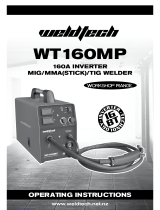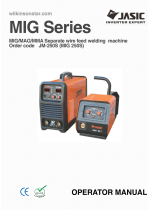
TABLE OF CONTENTS
1 SAFETY .................................................................................................................................7
1.1 Meaning of symbols.............................................................................................................7
1.2 Safety precautions ................................................................................................................7
1.3 User responsibility ............................................................................................................. 11
2 INTRODUCTION
................................................................................................................13
2.1 Equipment ............................................................................................................................13
2.2 Overheating protection ...................................................................................................13
3 TECHNICAL DATA
.............................................................................................................. 14
3.1 EMP 205ic AC/DC specications ................................................................................... 14
4 INSTALLATION
...................................................................................................................16
4.1 User’s responsibility .......................................................................................................... 16
4.2 Lifting instructions ............................................................................................................16
4.3 Location .................................................................................................................................17
4.3.1 Assessment of area ..................................................................................................17
4.4 High frequency interference ..........................................................................................18
4.5 Main supply ..........................................................................................................................19
4.6 Recommended electrical-supply specications .....................................................20
4.7 Supply from power generators .....................................................................................20
5 OPERATION
........................................................................................................................21
5.1 Connections and controls ...............................................................................................22
5.2 Connection of welding and return cables ................................................................23
5.2.1 For MIG/MMA process ............................................................................................23
5.2.2 For TIG process .......................................................................................................... 23
5.3 Polarity change ................................................................................................................... 23
5.4 Shielding gas ....................................................................................................................... 24
5.5 Volt-ampere curves ........................................................................................................... 24
5.5.1 SMAW (Stick) 120 V ..................................................................................................24
5.5.2 SMAW (Stick) 230 V ..................................................................................................24
5.5.3 GMAW (MIG) 120 V ...................................................................................................25
5.5.4 GMAW (MIG) 230 V ...................................................................................................25
5.5.5 GTAW (DC TIG) 120 V ............................................................................................... 26
5.5.6 GTAW (DC TIG) 230 V ............................................................................................... 26
5.5.7 GTAW (AC TIG) 120 V ............................................................................................... 27
5.5.8 GTAW (AC TIG) 230 V ............................................................................................... 27
5.5.9 Duty cycle ...................................................................................................................28
5.6 Removing/installing bobbin ..........................................................................................29
5.7 Liner selection .....................................................................................................................29
5.8 Installing/Removing wire ................................................................................................29
5.8.1 Installing wire ............................................................................................................ 30
5.8.2 Removing wire .......................................................................................................... 31
5.9 Welding with aluminum wire ........................................................................................ 31
5.10 Setting wire-feed pressure .............................................................................................32
5.11 Changing wire-feed roller ...............................................................................................33
5.11.1 Removing wire-feed roller .................................................................................... 34
5.11.2 Installing wire-feed roller ...................................................................................... 35






















